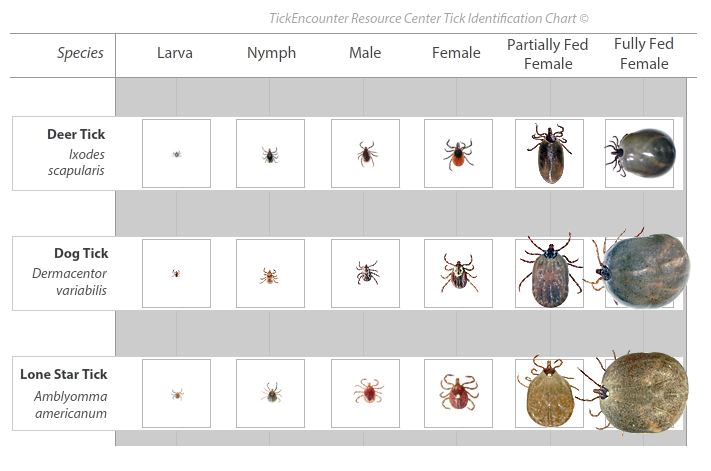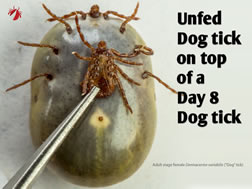Ticks
 No wonder ticks are so creepy....they are from the arachnid family (spiders!), having eight legs in the adult stage without antennae. There are two groups of ticks: hard ticks and soft ticks. Hard ticks are encountered much more frequently than soft ticks; in fact, most people will never see a soft tick. Both groups of ticks are capable of transmitting disease to animals, while the hard tick is responsible for transmitting diseases to animals and people.
No wonder ticks are so creepy....they are from the arachnid family (spiders!), having eight legs in the adult stage without antennae. There are two groups of ticks: hard ticks and soft ticks. Hard ticks are encountered much more frequently than soft ticks; in fact, most people will never see a soft tick. Both groups of ticks are capable of transmitting disease to animals, while the hard tick is responsible for transmitting diseases to animals and people.Perhaps the three most recognized hard ticks are the American Dog Tick, the Brown Dog Tick and the Blacklegged Tick, commonly known as the Deer Tick. Although each tick has certain species-specific characteristics, there are some characteristics all hard ticks have in common. Besides eight legs and no antennae, these ticks have a hard shell with the mouth area attached directly to the shell.
American Dog Ticks tend to be reddish brown in color and appear very flat when they have not eaten lately. After the female hard tick has fed, she resembles a small bubble or grape. Males do not seem to change their shape after feeding.
Brown Dog Ticks are often called Kennel Ticks because they are mainly found in kennels as well as homes where there are dogs. These ticks attach themselves to dogs and feed, but they are not generally known to attack people. Brown dog ticks can live indoors inside cracks in floors, among upholstery, and near heaters. The female is capable of producing over 3,000 eggs indoors! Yuck!
Deer Ticks, as the Blacklegged Ticks are now more commonly known, are also reddish brown in color, but are much smaller than the American Dog tick, so they are not as easily spotted on animals or people. In the nymph stage, they are only about the size of the head of a pin, making it even harder to see them when they attach themselves to people or pets. These ticks are the precursors of the dreaded Lyme disease, which can cause severe complications if untreated.
Reproduction of Ticks
All ticks, whether hard or soft, go through four stages of development. Females will lay their eggs after feeding. When the eggs hatch, the emerging miniscule six-legged larvae feed on a nearby host. After going through one or more molts, a larva becomes a nymph with eight legs. These nymphs in turn will molt and become adults who are ready to feed and reproduce.Tick's Habitat
Ticks are found throughout the United States, mainly in outdoor areas with woods, shrubs, weeds, and tall grasses. They are particularly found in humid environments and are often found in leafy debris. The only ticks generally found to live indoors is the Brown Dog Tick. Other ticks may enter the home via a pet or person who has been outside in tick-infested areas.Spraying lawn to treat ticks is the best course of action to prevent a tick outbreak. Spreading d-earth is also a good solution but will need to be applied after a few rains.
Tick Infestations
Insecticidal soap and pyrethrin-based sprays are best used in combination for tick control. Insecticidal Soap (Potassium Salts of Fatty Acids) & Pyrethrin. The soap will penetrate the tick's shell enough to weaken and dehydrate the arachnid and allow the pyrethrin to absorb in to the tick and kill it. Pyrethrin is a nerve agent and will paralyze and kill the arachnid on contact. Keep in mind this soap is not like dish detergent, it's a base from a blend of plant sources and pyrethrin oils and comes from the chrysanthemum flower. Use a contact killer for your entire lawn area. Keeping grass short will inhibit tick infestation.
Ticks can be present at any time of year in the south. Their activity decreases in colder weather and increases in warmer weather. Also, many species of ticks will go into a state of diapause when food sources are scarce. Diapause is similar to hibernation except the animal does not grow during this time or molt to the next stage of life. Lawn treatments for ticks may be necessary year round in warmer climates but in more seasonal climates, tick treatments are probably only necessary in the spring & summer.

Natural Predators
Parasitic wasps and certain birds, particularly chickens or guinea fowl, eat ticks. And if you have any, be thankful for possums in the area. An adult possum loves to eat ticks and can consume thousands per day. The parasitic wasp lays its eggs inside a tick and when the eggs hatch, the emerging wasps kill the tick and feed on it. Attract these wasps by planting nectar or pollen producing flowers. They can also be bought commercially. Plant attracting flora early in the season so parasitic wasps may be present when tick larvae emerges. Most local greenhouses and garden centers can help you determine the right planting time for nectar and pollen producing plants to ensure that the pollen and nectar will be available when the wasps arrive.To search for ticks on your dog, run your hands over their body. Pay close attention to skin folds and crevices especially the ears and feet. Make sure you are in a well lighted area so you can closely examine anything that feels suspicious. There are many different types, sizes and colors of ticks, depending upon the species and life stage. Ticks will navigate the body virtually undetected until they attach to your dog and begin to feed on their blood and begin to swell. Some ticks such as the deer tick which transmits Lyme Disease are very tiny, about as small as a pencil point depending upon how engorged it is.
Removing a Tick when it has become attached can be tricky. Their mouth parts have razor sharp spines pointing the opposite way so that when they latch on they are very difficult to get loos without yanking off the head. Unfortunately doing this means their blood flows back into your pet and the odds of contract disease increase. At the very least, you may have a piece of the tick's head still embedded in the skin which can abscess.

Do NOT Remove a tick like this.
- Do not squeeze the body of the tick when you remove it
- Do not grab the tick with your bare hands
- Do not pinch, pull or wiggle the tick.
- Do not try to smoother the tick with alcohol or Vaseline
- Do not attempt to kill the tick by using a match or another device for burning it off
This will just make it release it's poisons into the host.
The Correct Way to Remove the Tick From Your Dog
1) Put some rubbing alcohol in a screw topped jar. You will want to put the tick in here in case you wish to have your veterinarian examine it.2) Put on latex or rubber gloves to protect yourself from the tick and its infective agents. It may also be helpful to have another person help hold and soothe your pet.
3) Firmly grasp the tick as close to your dog's skin as possible using your fine tipped tweezers or tick removal tool. With steady, gentle pressure, pull the tick straight out of the skin and place it in your screw topped jar. Do not use too much pressure or a twisting motion or jerk the tick or you may inject more of the tick's saliva and toxins back into your dog.
4) Occasionally, the mouth parts of the tick may remain. If so, try to remove as much as possible using your tweezers. But don't worry if you can't remove it all. Your dog's immune system will try to dislodge it over time by creating a site of infection or even a small abscess which you should disinfect as below and monitor.
5) Disinfect the bite site with a cotton swab socked in rubbing alcohol. Then clean with soap and water. Also clean your tweezers or tick removal tool with alcohol.
6) Closely monitor the bite site as well as the health of your dog over the next few weeks. If either becomes a concern, contact your veterinarian for assistance and take your tick with you for identification.
With the above knowledge you can safely protect your dog, your family and yourself from the dangers of all tick borne diseases, especially Lyme Disease. Remember to do regular checks and remove ticks immediately to safeguard against potential illness in your dog.



